EQing, is a crucial aspect of music production that can make or break the sound of an instrument in a mix.
When it comes to the trumpet, a brass instrument known for its powerful and bright tone, EQ plays a vital role in shaping its sound to fit various musical contexts.
In this comprehensive guide, we’ll cover everything from understanding the instrument’s frequency spectrum to advanced EQing techniques used by professional sound engineers.
Understanding the Trumpet’s Frequency Spectrum (Frequncy Chart Included)
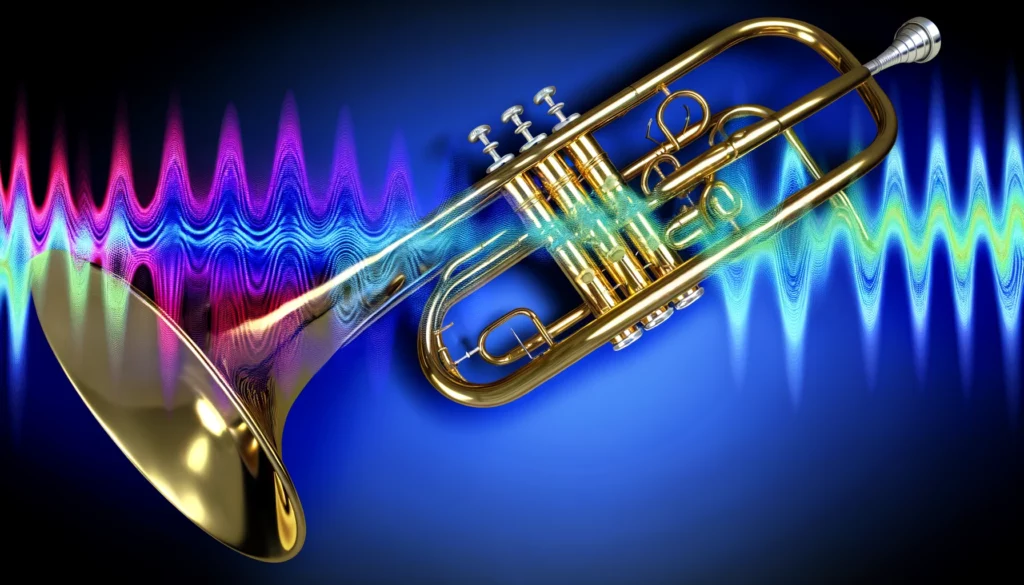
The trumpet has a distinct sound that is characterized by its rich harmonics and strong presence in the mid to high-frequency range. The fundamental frequencies of a trumpet typically lie between 160 Hz and 1000 Hz, with overtones extending well into the higher frequencies.
Understanding these key frequency ranges is essential for effective EQ-ing:
- Low frequencies (below 250 Hz) – Responsible for the warmth and body of the trumpet sound.
- Mid frequencies (250 Hz to 2 kHz) – Contains the core of the trumpet’s character and can affect its perceived “honkiness” or “brassiness.”
- High frequencies (above 2 kHz) – Contributes to the brightness, clarity, and articulation of the trumpet sound.
Here is the above frequncy range for a trumpet in a chart
| Frequency Range | Description |
|---|---|
| Low Frequencies (below 250 Hz) | Responsible for the warmth and body of the trumpet sound. |
| Mid Frequencies (250 Hz to 2 kHz) | Contains the core of the trumpet’s character and can affect its perceived “honkiness” or “brassiness.” |
| High Frequencies (above 2 kHz) | Contributes to the brightness, clarity, and articulation of the trumpet sound. |
Basic EQ Settings for Trumpet
When approaching EQ for a trumpet, it’s important to have a good understanding of the different types of EQ tools available:
- Parametric EQ – Allows for precise control over a specific frequency range, with adjustable frequency, gain, and Q (bandwidth) settings.
- Graphic EQ – Provides a fixed number of frequency bands that can be boosted or cut using sliders.
- Shelving EQ – Affects all frequencies above or below a certain point, making it useful for broad tonal adjustments.
As a starting point, consider these general EQ settings for a trumpet:
- Cut low frequencies around 200-300 Hz to reduce muddiness and improve clarity.
- Boost or cut mid frequencies around 500 Hz to 1 kHz to adjust the amount of “brassiness” in the sound.
- Boost high frequencies above 5 kHz to add brightness and presence, but be careful not to overdo it as this can result in a harsh or piercing sound.
🏆 Our Favorite Plugins for EQing Trumpets
We’ve found that FabFilter Pro-Q 3 is an excellent choice for EQing your trumpets.
Pro-Q3 is the most transparent and precise EQ on the market. This allows you to get the exact sound you want out of your trumpet track.
Equalizer Settings for Different Trumpet Styles
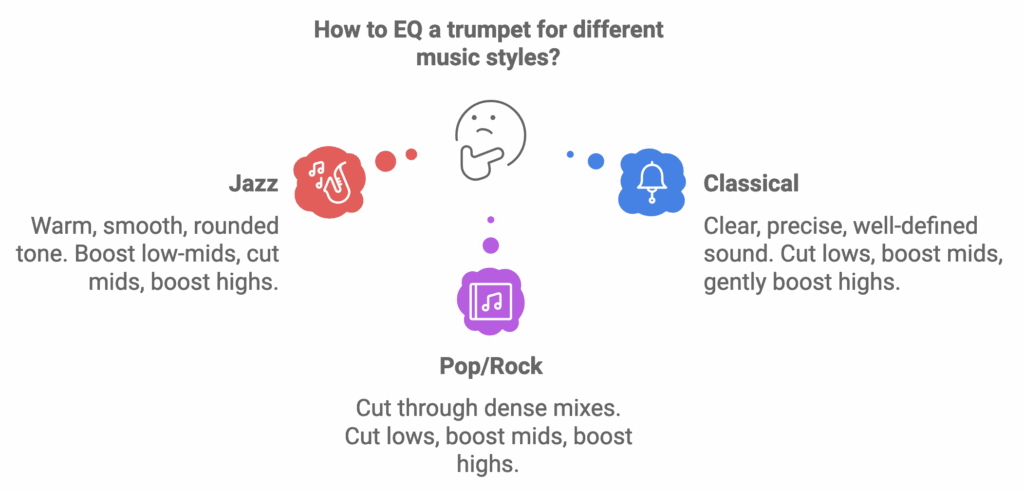
Jazz Trumpet
When EQ-ing a jazz trumpet, the goal is often to achieve a warm, smooth, and rounded tone. Here are some specific EQ adjustments to consider for this particular trumpet sound:
- Gently boost low-mid frequencies around 200-400 Hz to add warmth and body.
- Cut mid frequencies around 800 Hz to 1.2 kHz to reduce any harshness or excessive “honk.”
- Boost high frequencies around 4-8 kHz to add a subtle sparkle and enhance the trumpet’s natural overtones.
Listen to classic jazz albums like Miles Davis’ “Kind of Blue” or Chet Baker’s “Chet” for inspiration on the quintessential jazz trumpet sound.
Classical Trumpet Sound
In classical music, the trumpet often needs to sound clear, precise, and well-defined to cut through orchestral textures.
Consider these EQ techniques:
- Cut low frequencies below 200 Hz to minimize any boominess or muddiness.
- Boost mid frequencies around 1-2 kHz to enhance clarity and definition.
- Gently boost high frequencies around 6-10 kHz to add a touch of brilliance without sounding harsh.
Refer to recordings of renowned classical trumpeters like Maurice André or Wynton Marsalis for examples of a well-balanced classical trumpet sound.
Pop and Rock Trumpet Sound
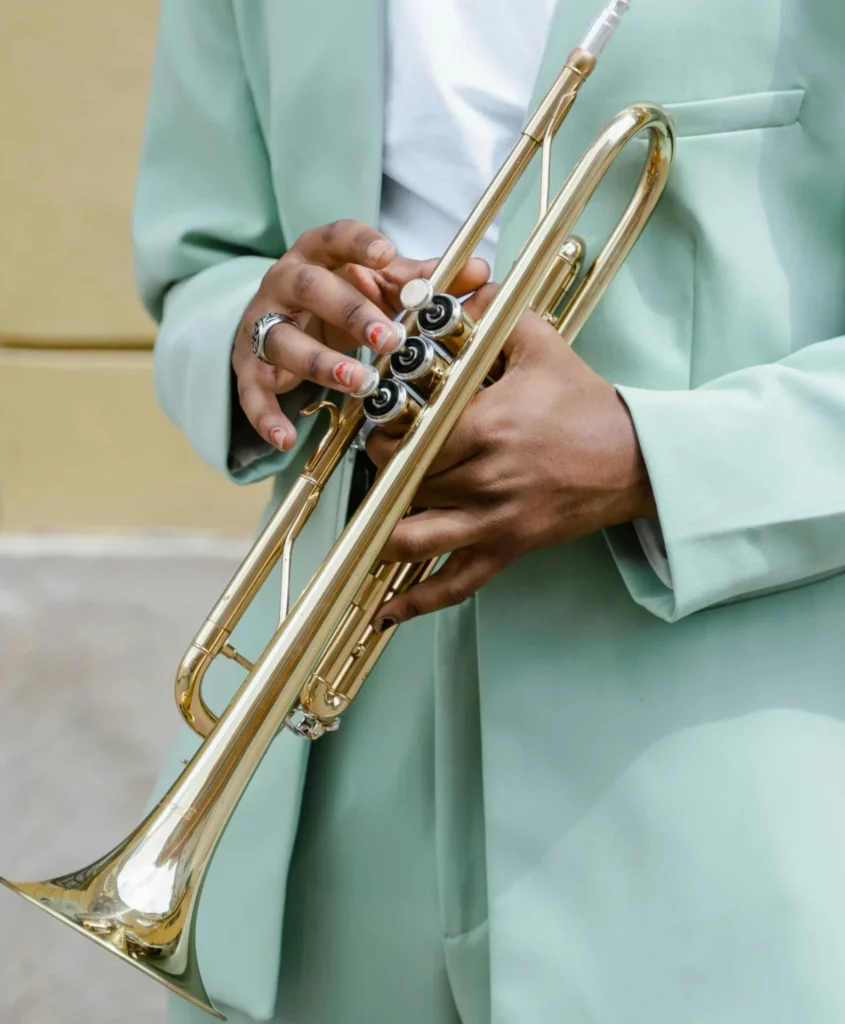
In pop and rock music, the trumpet sound often needs to cut through dense mixes and compete with electric guitars and synthesizers. Try these EQ settings:
- Cut low frequencies below 100 Hz to make room for bass instruments.
- Boost mid frequencies around 1-3 kHz to help the trumpet stand out in the mix.
- Boost high frequencies around 8-12 kHz to add excitement and help the trumpet cut through.
When EQ-ing for live performances, be mindful of the acoustics of the venue and adjust accordingly. Outdoor stages may require more high-frequency boost to compensate for the lack of natural room reverb.
🏆 Additional EQ Plugins We Use
FabFilter Pro-Q 3 is the first plugin that goes on our EQ chain. Then we add Pultec Passive EQP‑1A by UAD.
Why do we add 2 EQs? The Pro-Q 3 is incredible and percision and transparency, but doesn’t add a lot of character.
The Pultec Passive EQP‑1A brings that authentic analog rich sound that just works well on pretty much all live recordings.
Advanced Trumpet EQ Techniques
To take your trumpet EQ skills to the next level, consider using dynamic EQ and side-chain compression:
- Dynamic EQ – Allows for frequency-specific processing that only engages when a certain threshold is exceeded. This can be useful for taming harsh peaks in the trumpet’s sound without affecting the overall tone.
- Side-chain compression – Involves using the trumpet’s signal to trigger compression on another instrument, such as a bass guitar. This can help create space for the trumpet in a mix without drastically altering its EQ.
When dealing with common issues like harshness or muddiness, try these techniques:
- For harshness, use a narrow Q to locate and cut the offending frequency, typically in the 2-4 kHz range.
- For muddiness, use a high-pass filter to roll off low frequencies below 200 Hz, or use a wide Q to cut around 200-400 Hz.
EQ-ing Trumpet in a Mix
When EQ-ing a trumpet in the context of a full band mix, the key is to find a balance that allows the trumpet to be heard clearly without overpowering other instruments.
Here are some strategies to try:
- Start with a subtractive EQ approach, cutting frequencies that clash with other instruments before boosting.
- Use a high-pass filter to remove low frequencies that compete with bass instruments like kick drum or bass guitar.
- Be mindful of the frequency ranges occupied by other instruments, particularly other brass like trombones or saxophones, and make space for each instrument to shine.
Live Performance EQ Tips
EQ-ing a trumpet for live performances presents unique challenges due to the variability of acoustic environments.
Keep these tips in mind:
- Start with a flat EQ and make adjustments based on the sound of the room.
- In smaller venues, you may need to cut low frequencies to avoid boominess or feedback.
- In larger venues or outdoor stages, you may need to boost high frequencies to help the trumpet project and cut through the mix.
Be prepared to make quick adjustments on the fly, and always listen critically to how the trumpet sounds in the context of the live mix.
Common EQ Mistakes To Avoid
To ensure the best possible sound when EQ-ing a trumpet, avoid these common mistakes:
- Over-boosting high frequencies, which can result in a harsh or piercing sound.
- Neglecting to cut problem frequencies before boosting, leading to a cluttered or unbalanced sound.
- Applying the same EQ settings to every trumpet recording or performance, without considering the unique characteristics of each.
Always trust your ears and make adjustments based on what sounds best in the specific context you’re working in.
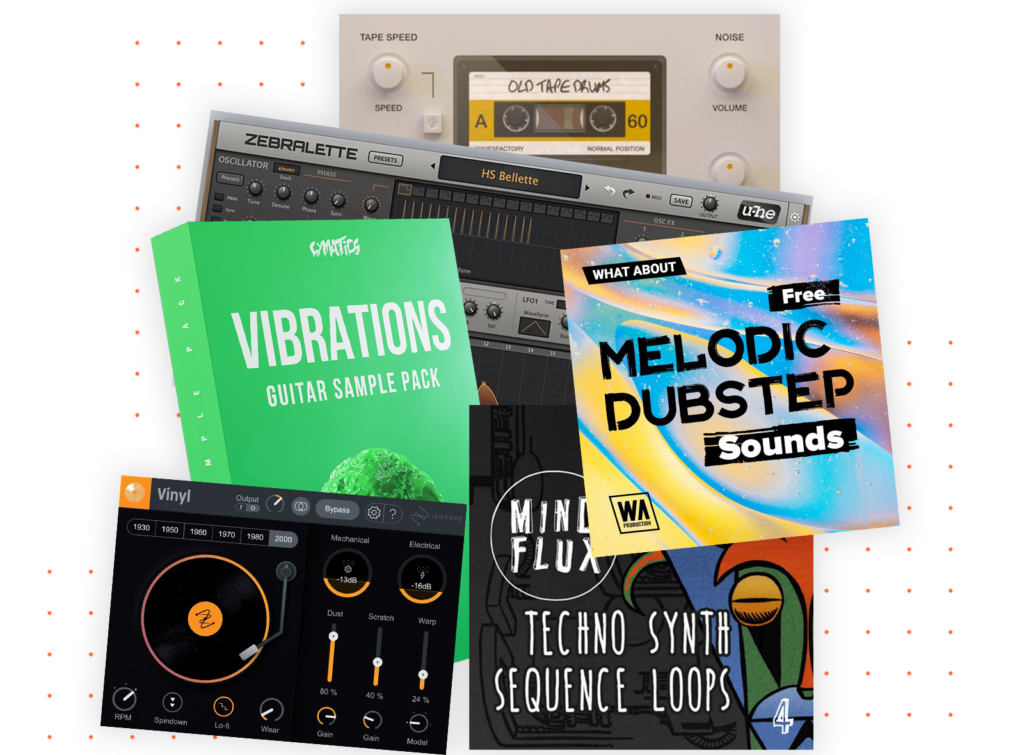
Access 4,000+ Music Tools
Access our entire library of music tools including sample packs, VST plugins, DAW templates, and much more.
Additional Resources
To further expand your knowledge of trumpet EQ and audio engineering, consider exploring these additional resources:
- “Mixing Secrets for the Small Studio” by Mike Senior – A comprehensive guide to mixing and EQ techniques for various instruments, including trumpet.
- “The Mixing Engineer’s Handbook” by Bobby Owsinski – A classic reference book that covers the fundamentals of mixing and EQ.
- “Pensado’s Place” – A popular YouTube series featuring interviews with top mixing engineers, offering valuable insights into their techniques and philosophies.
With dedication and practice, you’ll be able to take your trumpet EQ skills to new heights and create mixes that showcase the full potential of this powerful and expressive instrument.
Access over 4,000+ Music Production Tools
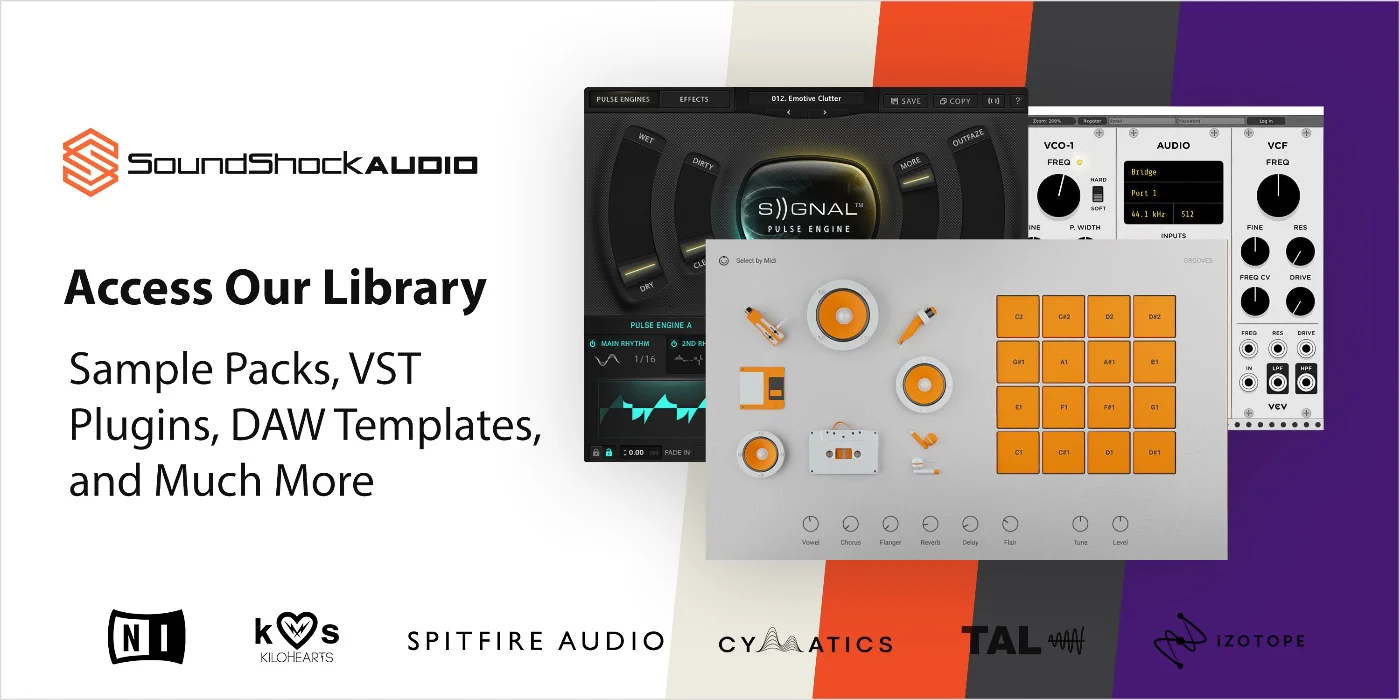
SoundShockAudio offers a comprehensive library of free music production tools, including VST plugins, Synth Presets, Kontakt Instruments, and more.
Subscribe today to start creating professional-sounding music with the best free tools available.
If you need more help with EQing, check out all of our articles on EQing.

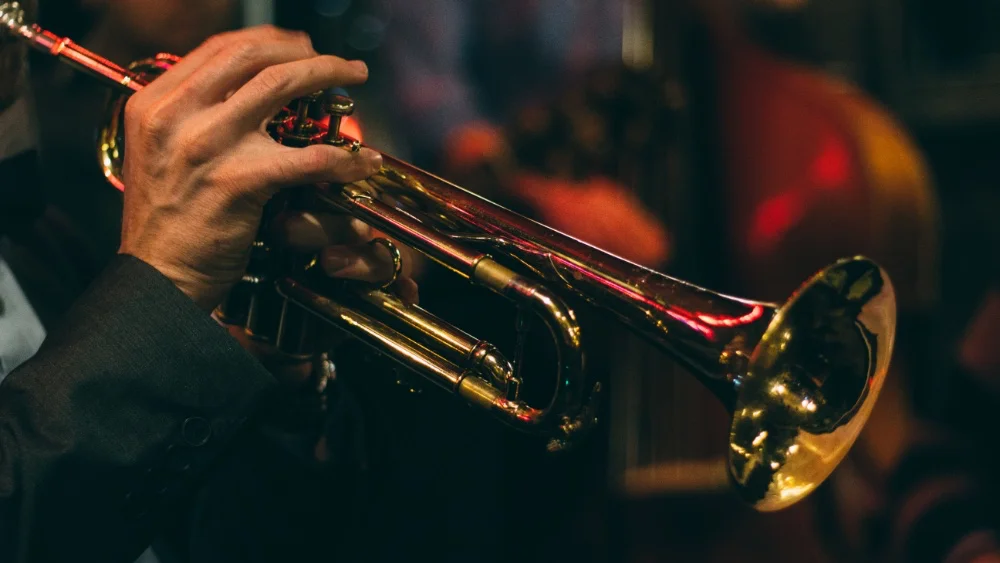


Hey Daniel, curious about the advanced EQ techniques for trumpet. Got any tips on balancing with vocals?
Balancing trumpets with vocals is all about the mid-range. Cut some mids on the trumpet, helps vocals pop out more.
Does it matter if the trumpet is playing the lead or just accents in these settings?
Hey Daniel, real quick, can you explain more about how to use EQ for a live gig? I got the basics but still mess up under pressure. Thanks, man.
is there a special EQ setting for jazz trumpets? kinda struggling over here :/
Read the part on EQ-ing trumpet in a mix. Solid advice.
Absolutely, applying these EQ techniques can really make the trumpet stand out in a crowded mix. Game changer for sure.
If I boost all the EQs, will my trumpet sound like a saxophone? Asking for a friend.
High quality EQ VST plugins won’t save a bad mix. People need to focus more on the basics.
While I do agree on focusing on fundamentals, the right tools can definitely help, especially in challenging situations.
I appreciate the EQ plugin recommendations. It’s tough to sift through what’s available out there.
Got a buddy plays the trumpet, gonna send him this. He’s always talking about how hard it is to get the sound right.
Guess trumpets are the only brass that matters now. What about us, trombone players, huh?
Daniel, the frequency chart is incredibly helpful for visual learners like myself. It’s one thing to hear about EQ, but seeing it laid out simplifies the complex.
Love the EQ tips for live performances. Really made a difference at my last gig!
Imagine if trumpets could talk, wonder what they’d say about all this EQ stuff.
Finally someone addressing EQ mistakes! Been there, done that with muddy mixes. Thanks for the heads up, Daniel.
That part about jazz trumpet EQ settings took me right back to the 50s. If only I had a time machine, right?